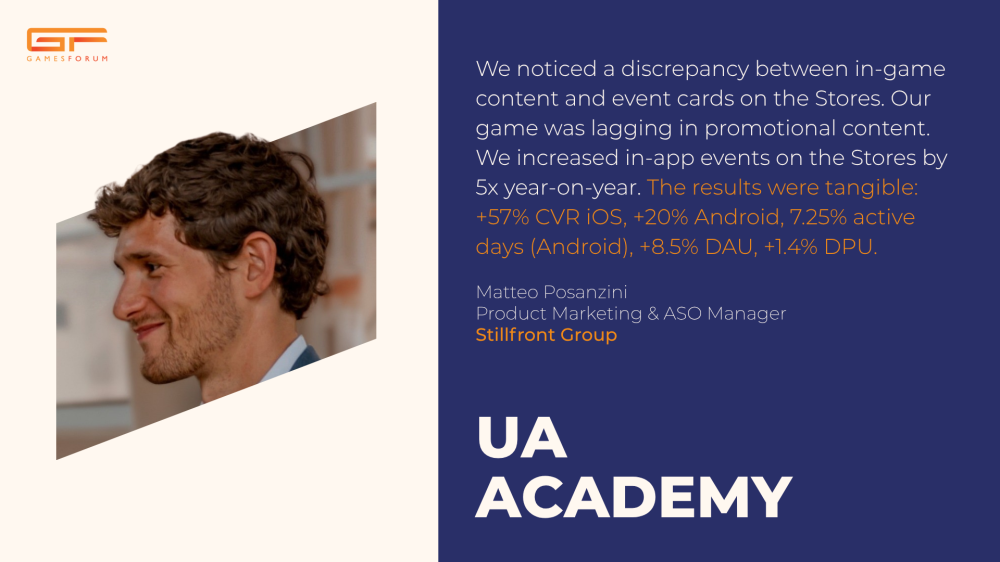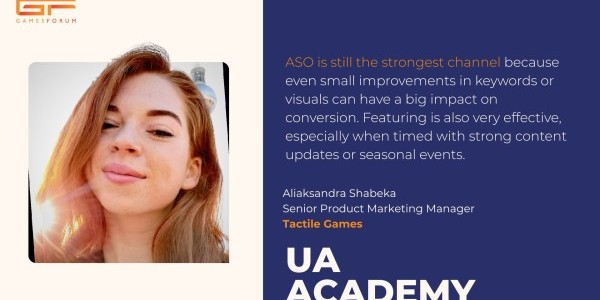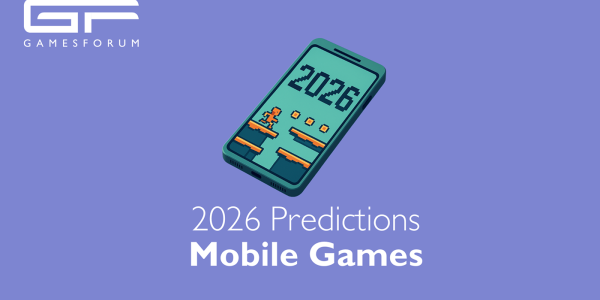UA Academy: Matteo Posanzini on Cracking the Code of Cross-Platform MMOs and Smart ASO

In this in-depth conversation, Matteo Posanzini, Product Marketing & ASO Manager at Stillfront Group, outlines a grounded, data-driven approach to cross-platform marketing in the MMO genre. He dissects the real-world complexity behind user behaviour across PC and mobile, debunks widespread myths about App Store Optimisation, and advocates for a player-first strategy that blends psychographic insight with platform-specific execution.
Cross-platform players don’t all wear the same armour - and strategy begins by asking who’s logging in where, and why
Being cross-platform presents several challenges, but many opportunities. Before starting defining a strategy, we need to understand key factors that will have a major impact on the strategy itself: what is the platform usage split? How many players are PC only, how many Mobile only, how many play cross-platform? What type of content do they consume? What is their play behaviour on the platforms? The first step is to understand the status quo. Define the starting point. Once this first step is done and we have understood our players’ behaviours, preferences and habits, we can start defining our marketing strategy.
The first aspect that I would define when it comes to the strategy is the objective. Do we want to acquire new users? Re-activate churned ones? Or increase the engagement of the existing player base. Each of these objectives requires a different approach, but at the core there’s always the same: the player.
Next, we need to understand what are the key motivational drivers of the segment that we are targeting (Progression, Competition, Cooperation, …). In other words, the Psychographic. What attracted them to download the game, what kept them engaged. If they churned, why, and if they returned, what brought them back.
The rest comes as a consequence of the audience segmentation: better, fine-tuned creatives reduce costs; players that find the game content highly relevant, will churn less and increase the retention rate. The right in-game content has higher chances of re-activating inactive players, and so on. Communication and cooperation with the development teams is crucial, as the marketing and the user experience (or FTUE - First Time User Experience), have to go hand-in-hand.
Thinking ASO is just keywords is technically correct, but entirely misleading
The first challenge that I often face when providing ASO support is that ASO is purely a technical SEO-like exercise of keywords optimization. First of all, keywords optimization is, today, probably the least impactful part of ASO. Audience segmentation, creative optimization, using CSLs and CPPs for organic and paid traffic, content management. These are all, to name a few, more important aspects of ASO as of today.
Another misconception is that one-size-fits-all markets. Assuming that the same creative and keyword approach works globally is wrong. The environment we are in shapes us and our gaming expectations.
Lastly, that ASO is a one-time setup. It is not, it is a living process. Midcore audiences evolve as the game matures, and so must the visuals and messaging.
Switching from ‘what we built’ to ‘why they care’ is the lever that moves performance
In my presentation at Gamesforum Hamburg, I talked about the 4 pillars of the strategy (Audiences > Needs > CSLs > Creative & KWs optimization) and how to practically execute on the strategy.
Today, we have access natively to a decent ASO toolkit to segment our audience based on their interests, therefore marketers can tailor the message around players’ expectations. Instead of focusing on why YOU think that your game is great, focus on what value players see in your game. talk to your players to understand what USP they see in the game. What you need to keep in mind though, is that each player segment might play your game for different reasons.
Then act based on the learnings. Use Custom Store Listings and Custom Product Pages. Separate Organic traffic from Paid traffic. Adjust your message to the audience segment. Experiment and optimize. Sit together with the Product team to study methods to re-engage churned players and to increase early retention based on the marketing signals. Leverage in-game content with Store featuring to boost the game visibility.
Brand identity isn’t about identical twins on PC and mobile, it’s about shared DNA adapted for different habitats
It is a complex but critical task. It’s about preserving the core essence of the game while adapting the messaging to the expectations and behaviors of each audience. Doing this consistently can be done only with a strict cooperation with Brand managers and creative teams.
The first step is to build the immovable foundations of the Brand, and document it into a Brand Bible containing the vision of the game, the tone of voice, the key values or pillars, and the visual DNA. The dos and don’ts.
Once that is defined, we need to adapt delivery, not essence.
Hitches can happen, but the way to firmly reduce the risk is to establish feedback loops and quality assurance gates with Brand managers already during the creative process, reducing at the same time the risk of extra work for creative teams.
The product marketer is the translator at the negotiation table between what devs build and what players actually want
Product marketing ensures that both sides (product and performance marketing) speak the same language and are aligned on what the game is, who it's for, and how to grow it sustainably. An exhaustive explanation is impossible to give in a few lines, as the needs of a game change and evolve together with the development stage the game is in.
For a live and operating MMO, PPM’s job is to understand players’ expectations and pain points to remove bottlenecks, translate new game features into marketable value, empower UA teams to target new users more precisely and define updates GTM strategies that resonate with the target audience; all this while owning the positioning and messaging of the game to create a strong and long lasting Brand identity.
When marketing, fixing a disconnect between store promises and in-game reality is like closing a leaky faucet - retention flows better
Last year we noticed a discrepancy between the limited-time content that was actually offered in-game and the use of event cards on the Stores. Furthermore, our game was lagging behind the competition in terms of promotional content / in-app events.
We prioritized this problem and quickly tackled it by increasing the amount of in-app events advertised on the Stores by 5x year-on-year, analysing the impact of different events and rewards in parallel to continuously optimize them.
The results were tangible: +57% CVR of returning users for iOS; +20% Android. 7.25% active days from users who engaged with the promotional content (Android). +8.5% avg. DAU. +1.4% DPU.
To scale a game globally, you have to translate culture
We already talked about the importance of safeguarding the Brand identity of a game for long-term success. When it comes to marketing an MMO in different regions, or scaling, Brand should remain the North Star to follow, therefore we would never lean into fake gameplay, or hypercasual features for mass targeting. Nevertheless, there are adjustments, as you called them, that must be considered in the marketing strategy. When you think about it, there are not many variables in the equation of a game: the art style, the core gameplay loop, the key features, these are all fixed elements that can’t be changed. What we can do though, is to prioritise certain aspects of the game over others.
For example, the Eastern and the Western markets are extremely different, in particular in the MMO genre. In general terms, in the Western culture PvE elements are predominant and PvP is more niche. The Eastern culture is on the other hand heavily PvP driven. On the monetization level, free-to-play (F2P) with heavy microtransactions (pay-for-convenience, cosmetics, buffs etc.) are common in Asia, whereas in the Western market game developers have to be more cautious.
If we look at ASO screenshots, we would notice how Eastern games favour long CTAs, bright, aggressive fonts and stats-heavy UI; pretty much the opposite of what we see in the West.
These examples are to say that if you want to break into regional markets, you have to understand what they expect first. You have to study the local culture and adapt your marketing to it, for example prioritising PvE or PvP messages.
If installs are the first date, long-term value is the marriage - and you’d better understand how your players live
Having the right MMM in place is key, particularly when you are present on multiple platforms. Without a clear understanding of players’ journey and behaviour, it is difficult to assess the effectiveness of a strategy. It is a long-term game, but ultimately what we want to see is an increase in retention metrics and LTV and a reduction in UAC and churn rate. We want to have a clear understanding of how the different platforms interact with each other: do players download on PC first and move to mobile for an on-the-go experience? Do they begin their journey on Mobile and then continue playing on PC? What type of player is each platform attracting? Younger players on Mobile, older on PC? Where are the spenders? Where are the players that contribute the most to the community? Acquiring this kind of knowledge is already a win, crucial to defying the next steps and adjusting the strategy moving forward for a game that wants to build a legacy and looks to the future.











